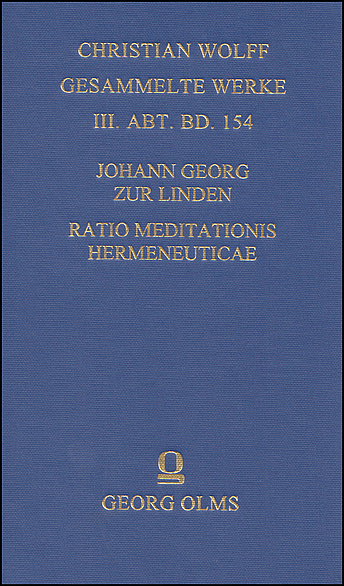Cataldi Madonna
Johann Georg Zur Linden: Ratio meditationis hermeneuticae
ISBN 978-3-487-15676-7
englischIn 1735 Johann Georg Zur Linden published his "Ratio meditationis hermeneuticae imprimis sacrae methodo systematica proposita" in Jena. His work was the result of an unexpected alliance between the Wolffian Enlightenment and Pietism, after the fierce clash between these two trends which had culminated in Wolff’s banishment from Halle. In the years that followed a new cultural figure appeared, the Enlightener-Pietist, or vice versa, who was to dominate the high and late Enlightenment and of whom Zur Linden was one of the first examples. Although the Ratio takes as its starting-point the rules of logical hermeneutics, it is based in an evaluation of the themes of classical rhetoric, and conceives hermeneutics as a technique, grounded in means-end rationality, the task of which is to determine the best method for understanding texts and speech. Zur Linden’s sacred hermeneutic theory is distinguished by at least four innovative aspects: 1. The proposal of a general hermeneutics of a probabilistic type. 2. An intensive examination of the different concepts of sense and their interrelationships. 3. The critique of better understanding as the goal of exegesis. The critical points of the text should not be obliterated in favour of its consistency. 4. The possible lack of agreement between what the author intends to say and what he actually says. For Zur Linden the sense of the text takes undoubted precedence and constitutes the only possible access to the author’s sense. His author-related textual hermeneutics can still be seen today as an original and noteworthy achievement.
1735 veröffentlichte Johann Georg Zur Linden in Jena die "Ratio meditationis hermeneuticae imprimis sacrae methodo systematica proposita". Sein Werk ist das Resultat eines unerwarteten Bündnisses zwischen der wolffschen Aufklärung und dem Pietismus nach dem harten Zusammenstoß dieser beiden Richtungen, der seinen Höhepunkt in der Verbannung Wolffs aus Halle fand. In den folgenden Jahren trat eine neue kulturelle Figur in Erscheinung, der Aufklärer-Pietist oder umgekehrt, der die Hoch- und Spätaufklärung beherrschte und zu dessen ersten Repräsentanten Zur Linden zählt. Obgleich die Ratio von den Vorschriften der logischen Hermeneutik ausgeht, beruht sie auf einer Aufwertung der Themen der antiken Rhetorik und konzipiert die Hermeneutik als eine auf die Mittel-Zweck-Rationalität gestützte Technik, der die Aufgabe zukommt, die besten Mittel für das Verstehen von Texten und Reden festzulegen. Die heilige Hermeneutik von Zur Linden zeichnet sich durch wenigstens vier innovative Aspekte aus: 1. Den Vorschlag einer allgemeinen Hermeneutik probabilistischer Art. 2. Eine eingehende Untersuchung der verschiedenen Sinnbegriffe und ihrer Wechselbeziehungen. 3. Die Kritik am Besserverstehen als Auslegungsziel. Die kritischen Punkte des Textes dürfen nicht zugunsten seiner Nichtwidersprüchlichkeit ausgemerzt werden, weil jede Verbesserung leicht in eine Manipulation des Sinns ausarten kann. 4. Die mögliche Nichtübereinstimmung zwischen dem, was der Autor sagen will, und dem, was er tatsächlich sagt. Für Zur Linden hat der Textsinn unzweifelhaft Vorrang und bildet den einzigen möglichen Zugang zum Autorsinn. Seine autorbezogene Texthermeneutik stellt sich noch heute als originelle, beachtenswerte Leistung dar.


